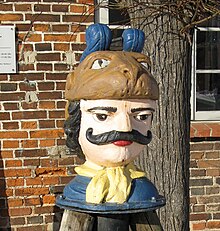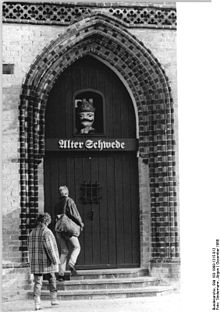Swedish heads
The Swedish Heads are a landmark of the Hanseatic city of Wismar . The brightly painted Hercules busts mark the entrance to the Wismar harbor on Duckdalben in the Wismar Bay in front of the Wendorf district . A preserved baroque original is now in the City History Museum of the Hanseatic City of Wismar (Schabbellhaus). Replicas can be seen in various parts of the city today.
background
There is speculation about the background of the Swedish heads, the exact reason and the time of their formation are unknown. They are not understood as a greeting alone. Due to the two pairs of eyes, one natural and then the one in the lion's cap on the head, they could also be seen as an attentive guard for the city and the seaport. In the imagery of antiquity, the lion's cap has stood for Herakles / Hercules , who had to perform twelve great deeds, since the Nemean lion was slain. The two dolphins with the Hercules heads in Baroque emblematic design became columns of Heracles , which bordered the port entrance and at the same time signaled non plus ultra (not beyond).
It is also possible that the baroque heads are baroque ship decorations, so-called rudder heads. In the 17th century, power and wealth were demonstrated, among other things, by decorating the ships.
In terms of linguistic history, Friedrich Techen established in 1925 that "Schwedenkopf" was an everyday word around 1800. It did not refer to sculptures or the like, but rather described a short hairstyle that was considered a symbol of modernity and enlightenment and replaced the old-fashioned braid.
history
For a long time it was assumed that two Swedish heads were already in the harbor entrance in the 17th century, since the dolphins were already known as Old Swedes at that time. However, the heads cannot be identified on historical illustrations and in travelogues. An article in the Mecklenburg daily newspaper of May 24, 1903 mentions a ship accident in the autumn of 1902. A freighter from Finland rammed the dolphins with the Swedish heads on them, which had been there "for a century" and were badly damaged. An iron foundry then made cast iron replicas, which were installed in May 1903.
Extensive research into the origin of the Swedish heads in the literature in preparation for the Sweden Festival 2003 in Wismar did not produce a clear result. Computed tomography (CT) and X-ray examinations led to the realization that the original, exhibited today in the City History Museum, consists of several layers of carved oak. Rotten, original pieces of wood and subsequently added, supporting pieces of wood are often nailed up. The nails prevented an exact age determination as they outshone the annual rings of the wood in the CT images.
In the course of the preparations for the Sweden Festival, the Swedish heads were discovered as an advertising figure, and between 2000 and 2003 25 replicas made of glass fiber reinforced plastic (GRP) were created in a Berlin company. One was handed over to the Swedish Institute in Stockholm and can be seen today in the Naval Museum in Karlskrona . Another head went to the Malmö municipality in Sweden. In Wismar there are two of the replicas on the Duckdalben in the port entrance. You can see them from the pier in the Wendorf district, among other places. Two more copies are kept as a reserve for this location. A large part of the heads was acquired by companies and private individuals or given to schools and colored according to their own ideas. They advertise the city and its history at various points in the Wismar urban area. One head is on the island of Poel , another was stolen.
Older replicas are now on indicated dolphins to the left and right of the entrance to the historic tree house in the Old Harbor . These are the cast iron replicas that were attached to the Duckdalben in 1903. Another Swedish head can be found on the market in the portal of Wismar's oldest brick-Gothic town house, which is called the Old Swede . This decoration was reinstalled as part of restoration work in 1989, but was in a similar form before the Second World War.
Web links
Individual evidence
- ↑ Example: Heracles from the east gable of the temple of Aphaia in the virtual museum of antiquities at the University of Göttingen
- ↑ a b c d Werner Augustat, Bernd Wulff: The Swedish Heads in Wismar , Penta Media, Wismar 2004
- ^ Klaus-Dieter Hoppe: Secret of the Swedish heads revealed , Mecklenburg-Magazin of the Schweriner Volkszeitung, edition 9/1992
- ↑ Baumhaus Wismar ( page no longer available , search in web archives ) Info: The link was automatically marked as defective. Please check the link according to the instructions and then remove this notice. on kulruboje.de
Coordinates: 53 ° 54 ′ 45.2 " N , 11 ° 26 ′ 12.9" E


